November itinerary in Japan Day 5 (Fukuoka Day 3 Meal edition)
(Friday, November 19th)
Table of contents
1. Originator Kawara soba “Takase”
3. Daiheizan Mojiko Main Store
1. Originator Kawara soba “Takase”
Immediately after arriving at Mojiko, I had the Kawara Soba Mentaiko Chazuke set (Yen 1,760 including tax) at the Originator Kawara Soba “Takase” on the 2nd floor of the Kaikyo Plaza West Building. Kawara soba is a local gourmet in Shimonoseki City, Yamaguchi Prefecture. Kawara soba began in 1962 when Shinichi Takase, who ran an inn in Kawatana Onsen, Shimonoseki, offered it as a dish for guests. After that, Kawara soba became a specialty of Kawatana Onsen and is served not only in Shimonoseki City but also in Yamaguchi Prefecture as a whole.

Shinichi Takase was inspired by the story of an old man who used tiles to bake and eat wild grass and meat during long field battles at the Satsuma Rebellion (1877), and developed Kawara soba. Kawara soba is served with beef, Kinshi-tamago (thin omelette cut into strips), seaweed, Momiji-oroshi (grated daikon and chili) , and lemon on top of tea soba.
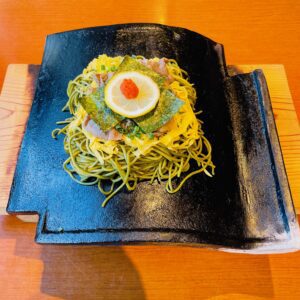
The way to eat Kawara soba is as follows: (1) First, add the ingredients and Cha-soba to the soup, (2) Then add lemon and Momiji-oroshi, and (3) Finally, eat the Cha-soba that is crispy with hot tiles.
I had Kawara soba for the first time and it was delicious soba. I think it’s a fun soba that it’s difficult to eat without dropping the ingredients on the curved roof tiles, and eating itself becomes a kind of event.
The reason why I ate Kawara soba at Mojiko is because it is a local gourmet in Shimonoseki City, Yamaguchi Prefecture. Moji Port and Shimonoseki City are neighboring towns connected by the Kanmon Bridge and the Kanmon Tunnel. Mojiko Station and Shimonoseki Station take only 20 minutes by train or car. Moji Station and Shimonoseki Station are only 6 minutes by train. In this way, Mojiko and Shimonoseki are closely connected geographically and economically, and it is no exaggeration to say that the local gourmet of Shimonoseki is the local gourmet of Mojiko.
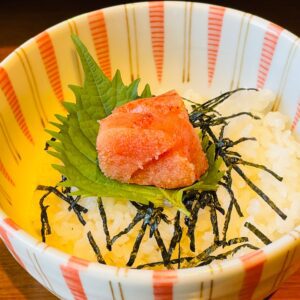
The Mentaiko chazuke of the Kawara soba Mentaiko chazuke set I had is a genuine local gourmet in Fukuoka prefecture. The Ministry of Agriculture, Forestry and Fisheries has selected Karashi-mentaiko (spicy cod roe) as one of the “Local dishes loved by the nation” in Fukuoka Prefecture. Karashi-mentaiko is sold nationwide and can be eaten in Tokyo, but I tried it in Fukuoka prefecture just in case. As I can imagine, it was a delicious Karashi-mentaiko.
2. MOJIKO BEER
As I wrote in the BLOG two days ago, we can drink the craft beer “MOJIKO BEER” at the Mojiko Retro Observation Room. It was great to drink craft beer while looking at the Kanmon Strait. The “MOJIKO BEER” Weizen I drank won the highest award of the National Craft Beer Quality Examination Committee twice. It was a delicious beer.
The unfortunate thing about Mojiko Beer is that although it is manufactured in Moji Ward, there is no store in Moji Ward that offers draft beer. There used to be a Mojiko beer shop in Mojiko, but it closed in September 2020 and is now open only in Kokurakita Ward. Since Mojiko has a well-established economy in the tourism industry, the negative impact of COVID-19 seems to have been serious. I would like the store to be revived at Mojiko someday.

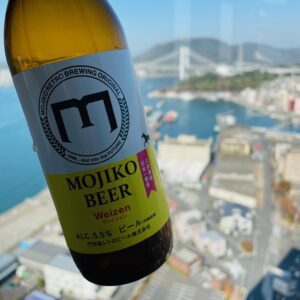
3. Daiheizan Mojiko Main Store
The ramen shop I found by chance while taking a walk in Mojiko Retro is “Daiheizan Mojikoko Store“. Local customers were steadily entering the Daiheizan, and there was also a waiting room next to the entrance of the store that could accommodate about 10 people. I thought this ramen shop was a popular store, so I entered the store.
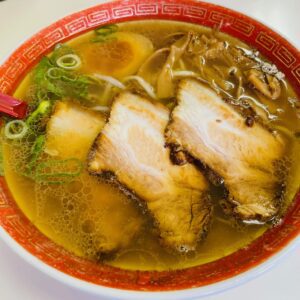
As a result, it was a big hit. I ordered Daiheizan ramen (Yen 800 including tax). It was a ramen with soy sauce and tonkotsu (pork bones), and it was one of the top 5 in my life history. Maybe it was my best ramen in my life. The soup has a perfect balance of soy sauce and tonkotsu, and the pepper that was applied from the beginning really matched the soup. It was a delicious taste that was hard to express. Also, the noodles themselves were very delicious. It went well with the soup and it produced a synergistic effect. The roasted pork fillet, Ajitama (soft-boiled egg marinated in soy and mirin) , and menma (sungan) were also exquisitely seasoned. This ramen was so delicious that I thought I could continue to eat it forever.

Unlike Hakata ramen and Kurume ramen, there was no Kaedama (noodle refill) at “Daiheizan”. If you add a Kaedama, the balance between the noodles and the soup will be lost, so I strongly agree with the policy of “Daiheizan”, which does not have a Kaedama.
I was happy to meet a delicious restaurant that would make me want to revisit Moji Port to eat ramen at “Daiheizan”. If you are visiting Mojiko, this is a ramen shop that you should definitely visit.
4. Kagoshima highball
I drank “Kagoshima Highball” in the Shinkansen train from Kokura Station to Hakata Station. “Kagoshima Highball” is a highball that uses the Otsu-rui shochu “Hozan” sold in 2015. Taste and Aroma Strategic Research Institute developed and sold it in cooperation with Nishi Sake Brewery in Kagoshima, which produces “Hozan”. It has a very mellow taste and is my favorite highball.

In addition, “can chu-hi” is mainly made with Ko-rui shochu, vodka, and spirits. On the other hand, there are almost no products that use Otsu-rui shochu, and “Kagoshima Highball” is a very rare product. Otsu-rui shochu is a single-distilled shochu with an alcohol content of 45% or less, and you can enjoy the flavors and tastes of the raw materials such as rice, potatoes, wheat, and soba. On the other hand, Ko-rui shochu is a shochu with an alcohol content of less than 36% by continuous distillation, and it is colorless and transparent, and the price is low.
5. Izakaya Hikari
After arriving at Hakata Station, I went to “Izakaya Hikari”, which is a 1-minute walk from the Chikushi Exit of Hakata Station. “Hikari” is a long-established popular izakaya that was full after 6 pm, and many people were refused entry.
I ordered blue mackerel, Sansaimori (three kinds of sashimi), squid sashimi, longtooth grouper sashimi, fried kanato-fugu (half-smooth golden pufferfish), and Game-ni.
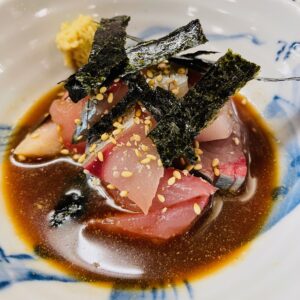
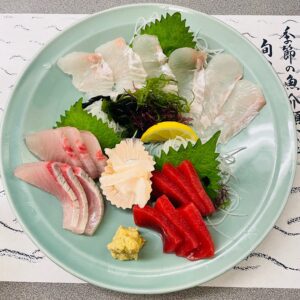
The blue mackerel, the flounder, of Sansaimori (three kinds of sashimi), great amberjack, tuna akami, and fried kanato-fugu were excellent. Longtooth grouper sashimi sashimi was not good at fat. Longtooth grouper sashimi is a high-class fish that is also called Ara in Fukuoka Prefecture. The season is winter in January and February. After all, we have to eat seasonal fish and shellfish.

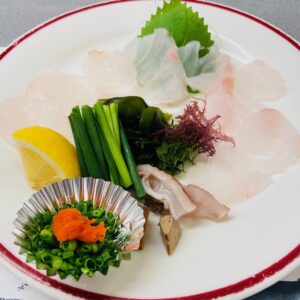
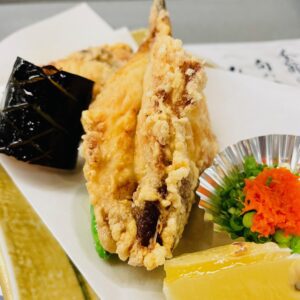
Squid (season: April-November) and Kanato-fugu (season: August-December) have been selected by the National Federation of Fisheries Cooperatives as “PRIDE FISH” in Fukuoka Prefecture. Kanatofugu is also called Shirosaba-fugu, as I introduced in the BLOG on December 10th. It has been loved by people in Fukuoka prefecture because it is more affordable than tiger puffer.
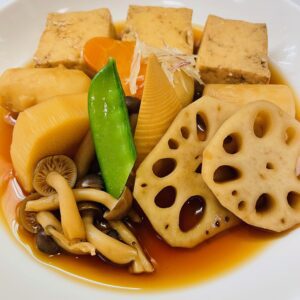
Game-ni is a local dish of Fukuoka prefecture, also known as “Chikuzen-ni”. It has been selected as one of the “100 Best Local Cuisine” by the Ministry of Agriculture, Forestry and Fisheries.
“Izakaya Hikari” is a popular restaurant, so most of the meals were delicious and I left the restaurant with great satisfaction. It is a recommended izakaya because it is conveniently located near Hakata Station.
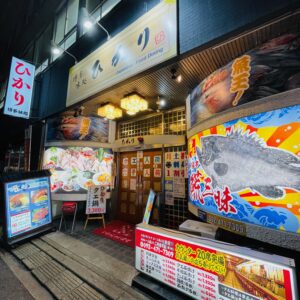
Note: The departure / arrival times, fares, admission fees, meal fees, etc. of the transportation facilities listed in the text are as of the time of writing the BLOG. They may change in the future, so Please verify yourself when you go on a trip.